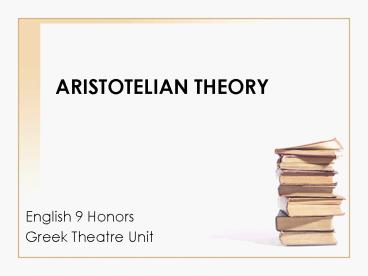ARISTOTELIAN THEORY - PowerPoint PPT Presentation
Title:
ARISTOTELIAN THEORY
Description:
ARISTOTELIAN THEORY English 9 Honors Greek Theatre Unit What is the ARISTOTELIAN THEORY of tragedy? In his Poetics, the philosopher Aristotle laid out the idea that ... – PowerPoint PPT presentation
Number of Views:149
Avg rating:3.0/5.0
Title: ARISTOTELIAN THEORY
1
ARISTOTELIAN THEORY
- English 9 Honors
- Greek Theatre Unit
2
What is the ARISTOTELIAN THEORY of tragedy?
- In his Poetics, the philosopher Aristotle laid
out the idea that poetic art is the imitation of
an action. This imitation, or mimesis, is a
writers attempt to represent reality or truth in
artistic form.
3
Aristotle asserted the structure and purpose of
tragedy in the following terms
- UNITY OF ACTION tragic plots must have a clear
beginning, middle, and end, and the action should
be ordered and continuous, arising through a
cause and effect process.
4
Aristotle asserted the structure and purpose of
tragedy in the following terms
- CATHARSIS the events of the play should inspire
pity and terror in its viewers, allowing them,
through vicarious participation in the dramatic
event, to attain an emotional purgation, moral
purification, or clarity of intellectual
viewpoint.
5
Aristotle asserted the structure and purpose of
tragedy in the following terms
- TRAGEDY is characterized by protagonists who are
highly renowned and prosperous, (of noble
birth) and whose reversal of fortune and fall
from greatness are brought about not by vice or
depravity, but by some error or frailty. The
protagonists inner weakness or inherent error
(tragic flaw) is called the hamartia, taken from
the Greek word meaning to err or to miss the
mark. The hamartia is most often hubris..
6
- This reversal in fortune is characterized by
reversal of situation (peripeteia) and
recognition (anagnorisis). In Oedipus the
King, for example, Oedipus reverses his position
from that of the powerful and justly offended
pursuer of the evildoer who has polluted the city
to being himself pursued as the abhorred polluter
of the city. This same event brings about the
anagnorisis, as Oedipus suddenly recognizes
himself as the man who has broken unbreakable
taboos and committed unbearable, if
unintentional, wrongs. Aristotle believed that
in the most successful tragedies, the moment of
recognition and the reversal of situation take
place in the same narrative event.
7
- The scene of suffering must also take place in
tragedy (for example, the scene where Oedipus
blinds himself.) Aristotle, and the Greeks in
general, viewed suffering as a prerequisite for
wisdom.
8
ARISTOTLE AND HUMPTY DUMPTY
Humpty Dumpty sat on a wall
- Hes a noble protagonist set perilously in a high
place of power
9
Humpty Dumpty had a great fall
He experiences a reversal of situation he falls
from greatness his tragic weakness is his
frailty a thin shell and an error he
probably wiggled around, showing off, on the wall
or tried to stand up on it to get even higher.
His sin is pride like Yertle the Turtle in the
Dr. Seuss story or Julius Caesar in Shakespeares
play, he tried to rise too high, beyond his
natural boundaries.
10
All the kings horses and all the kings
menCouldnt put Humpty Dumpty together again.
The readers feel pity and terror. The egg is
cracked. The yolk streams out like blood. Poor
Humpty. Hell never sit on the wall feeling the
rush of the cool spring air on his shell, never
again experience the exhilaration of balancing
precariously on a tempting wall. He is dead and
gone, irreparably damaged and deprived of his
once-high position and enjoyable life.
11
And the same thing could happen to the readers
one of these fine days if theyre not careful.
Go a bit too fast in that golden Mercedes and
wind up spread across the highway crushed in a
lump of molten metal. Reach for that
high-yielding stock and end up broke. Overstep
the bounds of law and morality in reaching for a
high political office and end up ruined and
disgraced, resigning ignominiously (humiliated)
from your post, lucky to have avoided prison.
12
But it has not happened to us.
We have vicariously experienced the story and
learned wisdom from the suffering of the
protagonist. We leave the story or play with a
feeling of catharsis, an emotional release and a
purification of mind, heart, and soul.
13
(No Transcript)































